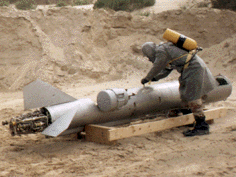Kh-28
| Kh-28 (NATO reporting name:AS-9 'Kyle') | |
|---|---|
 USAFEODspecialist disassembles presumed Kh-28 – Iraq 1991 | |
| Type | air-launchedanti-radiation missile |
| Place of origin | Soviet Union |
| Service history | |
| In service | 1973–current |
| Used by | FSU,[1]Warsaw Pact,[1]India,[1]Iraq,[1]Vietnam[1] |
| Production history | |
| Designer | Alexander Yakovlevich Bereznyak |
| Manufacturer | MKB Raduga |
| Specifications | |
| Mass | 720 kg (1,590 lb)[2] |
| Length | 597 cm (19 ft 7 in)[2] |
| Diameter | 43 cm (16.9 in)[2] |
| Wingspan | 193 cm (6 ft 4.0 in)[2] |
| Warhead | Blast fragmentation[1] |
| Warhead weight | 160 kg (353 lb)[2] |
| Engine | Two-stage liquid-fuel rocket[2] |
Operational range | 110 km (59 nmi)[3] |
| Maximum speed | Mach 3.0[2] |
Guidance system | Inertial guidancewithpassive radarseeker[1] |
Launch platform | Su-17M/Su-20/Su-22M, Su-24M, Tu-16, MiG-25BM, MiG-27, Tu-22M[4] |

TheKh-28(Russian:Х-28;Nisan-28;NATO:AS-9 'Kyle') was the firstSovietanti-radiation missile(ARM) for tactical aircraft.[1]It entered production in 1973 and is still carried on someSukhoi Su-22sin developing countries but is no longer in Russian service.[1]Use of the Kh-28 was restricted by its weight, limited seeker head, bulk and fuelling requirements, and it was superseded by the smaller, solid-fuelKh-58(AS-11 'Kilter') in the early 1980s.
Development[edit]
Soviet offensive doctrine in the early 1960s assumed that widespread use of nuclear weapons would disable Western radar-based air defence systems throughelectromagnetic pulses(EMP) effects.[3]Consequently, they paid little attention to the development of ARMs.[3]However, in January 1963 the Berezniak design bureau (which becameMKB Radugain 1967) was tasked with developing such a missile as part of the K-28P weapon complex based around a "Wild Weasel"version of theYak-28'Brewer' bomber (hence -28; the 'K' stands for kompleks, P stands for protivradiolokatsyonny 'anti-radar').[3]
The main difficulty came in the design of the APR-28 guidance system undertaken by CKB-111 (later NPO Avtomatika).[3]This meant that the Kh-28 missile was not ready until the 1970s.[3]Flight trials were carried out on a Yak-28N, but by then the Yak-28 had ceased production and was perceived as obsolete, and the K-28P system was cancelled.[3]Instead the Kh-28 was adapted for use by standard attack aircraft, in particular theSu-24'Fencer-A' and Su-17M 'Fitter-C'.[3]
Design[edit]
The Kh-28 was the first liquid-fuel Soviet ARM and was quickly replaced by the solid-fuel Kh-58 missile, according to research from Dr. Carlo Kopp, the editor in chief of Air Power Australia.[5]
The design of the Kh-28 was similar to – but smaller than – Raduga'sKh-22(AS-4 'Kitchen')[4]andKSR-5(AS-6 'Kingfish') anti-shipping missiles.[2]The Su-24 could carry one under each wing, and used the onboardFilin('Eagle Owl') targeting system.[3]The Su-17M could only carry one Kh-28 on the centreline, and used theMyetyel/Metel('Blizzard') system in a pod under the right wing, later replaced by theVyuga('Snowstorm') pod.[3]
The APR-28 seeker on the original Kh-28 could only target theMIM-14 Nike-HerculesandEnglish Electric ThunderbirdSAM systems, although theFilincould recognise other frequencies.[3]The Kh-28M had an updated X-band seeker that could recognise theMIM-23 Hawk's AN/MPQ-33 and subsequent AN/MPQ-39target-illumination radars,and the AN/MPQ-34 low-leveltarget-acquisitionradar.[1]Other seekers may have been produced.[1]
The propulsion system consists of a fuel tank and a separate tank for thered fuming nitric acid(RFNA) oxidiser. One problem was that the missile required fuelling just before flight, and not many airfields had the appropriate facilities.[2]Range is given variously as 80–95 km or 120 km.[2]
Operational history[edit]
The Kh-28 entered service with the Soviet Air Force in 1973, and has been widely exported. It was cleared for use on the Su-17M/Su-20/Su-22M, Su-24M, Tupolev Tu-16, Mikoyan-Gurevich MiG-25BM, MiG-27 and Tupolev Tu-22M aircraft.[4]It was also tested on anAntonov An-12BLSEADvariant of the transport that could carry four of the missiles.[4] A missile believed to be a Kh-28 was captured in Iraq by US forces during the first Gulf War in April 1991. One man was burnt by RFNA from the oxidiser tank while he was making it safe.[6]
Operators[edit]
- others
 Libyafrom
Libyafrom Libyaaviation arsenals
Libyaaviation arsenals Azerbaijan
Azerbaijan Georgiaunknown, active or depot in stockage or not operational
Georgiaunknown, active or depot in stockage or not operational Kazakhstanunknown, maybe active or on depot stockage
Kazakhstanunknown, maybe active or on depot stockage Ukraineunknown status or not operational
Ukraineunknown status or not operational Belarusunknown, probably active or stockage in depot
Belarusunknown, probably active or stockage in depot
Former operators[edit]
 Soviet Unionpassed on to successor states
Soviet Unionpassed on to successor states Afghanistan
Afghanistan Hungary
Hungary Iraq[7]
Iraq[7] Peru[8]
Peru[8] Poland
Poland South Yemen[9]
South Yemen[9]
Variants[edit]
- Kh-28(Izdeliye93, D-8) - original version targetingNike-HerculesandThunderbirdSAMs
- Kh-28M- improved version capable againstHawkand possibly other radars
- Kh-28E- export version
- Nisan-28orNissan-28- Iraqi version of Kh-28E displayed in Baghdad in 1989 that was reported to have three seeker heads for different frequency bands.[2]
Similar weapons[edit]
- AGM-78 Standard ARM– US anti-radar missile with similar range but only Mach 2.0
- Martel missileAS37 – Anglo-French first-generation anti-radar missile, subsonic with 60 km range
Notes[edit]
- ^abcdefghijkStaff ofJournal of Electronic Defense(2004),International Electronic Countermeasures Handbook,Artech House,ISBN978-1-58053-898-5
- ^abcdefghijkFriedman, Norman (1997).The Naval Institute guide to world naval weapons systems, 1997-1998.Naval Institute Press.ISBN978-1-55750-268-1.
- ^abcdefghijkFiszer, Michal; Gruszczynski, Jerzy (January 2003),"Crimson SEAD: An insider's view of suppression-of-enemy-air-defense weapons and doctrine, soviet-style.",Journal of Electronic DefenseAlso available fromAccessMyLibrary
- ^abcd"Kh-28 (AS-9 'Kyle')",Jane's Air-Launched Weapons,August 1, 2008, archived fromthe originalon January 27, 2013
- ^Snow, Shawn (August 25, 2017)."Kurdish fighters capture Russian anti-radiation missiles from ISIS".Military Times.RetrievedJanuary 3,2020.
- ^Rostker, Bernard (August 3, 1999),Information Paper - Inhibited Red Fuming Nitric Acid,Office of the Special Assistant for Gulf War Illnesses, archived fromthe originalon July 18, 2008
- ^Cooper & Sipos 2019,p. 19
- ^Tincopa 2018,p. 29
- ^Cooper 2017,p. 40
References[edit]
- Cooper, Tom (2017).Hot Skies Over Yemen, Volume 1: Aerial Warfare Over the South Arabian Peninsula, 1962-1994.Solihull, UK: Helion & Company Publishing.ISBN978-1-912174-23-2.
- Cooper, Tom; Sipos, Milos (2019).Iraqi Mirages. The Dassault Mirage Family in Service with the Iraqi Air Force, 1981-1988.Helion & Company Publishing.ISBN978-1-912390-31-1.
- Gordon, Yefim (2004),Soviet/Russian Aircraft Weapons Since World War Two,Hinckley, England: Midland Publishing,ISBN1-85780-188-1
- Tincopa, Amaru (2018).Su-22 Fitter.Australis.ISBN978-987-1682-60-7.
